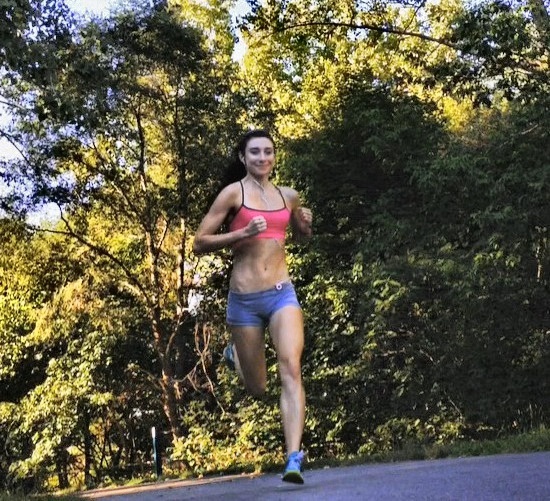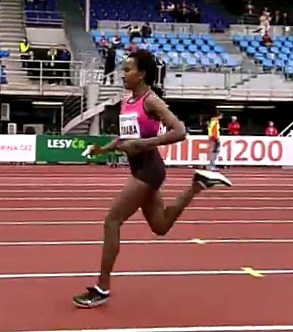Increasing cadence for running is an effective strategy to avoid injury, such as front of knee pain (Lenhart et al. 2014) as well as ITBS because taking smaller steps when running reduces peak hip adduction (Heiderscheit et al.2011), thereby relieve strain on the IT band.
Forefoot runners tend to have a higher step cadence than heel strike runners, suggesting that a higher cadence rate is an unintended attribute of forefoot strike running mechanics. However, in addition to forefoot running, here is another way to boost your step rate.
Ways to Increase Cadence for Running
When you are running forefoot, think of pulling your foot up, and not sending your foot to the ground at each step. A study by Craighead et al. found that stride rate increased and stride length decreased when runners were instructed to quickly lift the foot from the ground as opposed to emphasizing a push back and down against the ground.
When I run, I always think of kicking up my feet behind my body as doing so lightens the load for when my foot strikes the ground.
The researchers suggested that quickly pulling of the foot in forefoot running creates ideal kinematic conditions for a forefoot strike landing, which in turn would trigger other positive kinematic changes such as increased knee flexion and ankle plantarflexion at touchdown.
Forefoot Running Tips From the Study
The participants of the study focused on lifting the stance leg from the ground early, just after contact, and to bring the foot straight up to the buttocks. They were also told to use the analogy of imagining a wall directly behind them prohibiting backward movement of the foot.
Also, don’t force your feet up too high off the ground as this is unnatural, rather imagine your feet springy up to a comfortable target height. Visualize or feel your foot springing up from the ground.
The participants were also instructed to watch and learn from other participants. For me, I like to watch videos of Ethiopian runners (shown above) from the back or side because it shows how quickly their feet pop off the ground.
Another way to help increase your running cadence is by doing running drills that involved a suppressed arm swing. A study by Arellano and Kram (2011) found that step frequency increased by 2.5% when arm swing was suppressed. So, hold your arms like you normally would when you run, just don’t swing them, or swing them significantly less.
Why Reducing Stride Length and Increasing Stride Rate is Important
It is the combination of reduced stride length and increased stride rate that reduces overall impact loading. However, to maximize the protective effects of these mechanical variables, Pose Running emphasizes achieving the shoulder over hip over ankle at initial contact.
- To make this happen, align the ankle, hip and shoulder in stance during running by leaning forward allowing the body to fall forward, according to Pose Running.
Reducing stride length is also important for improving running economy.
- A study by Morgan et al. reported that 20% of recreational distance runners had a stride length that was too long, however the runners improved running economy after training for 3 weeks with reduced stride length.
In terms of injury prevention, Lenhart et al. concluded that increased stride rate was the most important predictor of the reduction in runners knee as hip, knee and ankle extensor forces, and hip abductor forces all reduced during midstance.
Therefore, increased stride rate limits the amount of time for any underlying muscle strength imbalances to interfere kinematically during contact.
More From Run Forefoot:
- How Modern Running Shoes Leads to Joint Obliteration
- Listening to Music During Running
- Neutral Running Shoes Increase Joint Susceptibility to Arthritis
- Forefoot Running Shoes
References:
Arellano, CJ and Kram R. The effects of step width and arm swing on energetic cost and lateral balance during running. J Biomech, 2011;44, 1291-1295.
Arendse, RE, Noakes, TD, Azevedo, LB, Romanov, N, Schwellnus, MP, and Fletcher, G. Reduced eccentric loading of the knee with the pose running method. Med Sci Sports Exerc 36: 272–277, 2004.
Craighead, DH., Lehecka, N and King, DL. A novel running mechanic’s class changes kinematics but not running economy. J Stren Cond Res, 2014; 28(11):3137-3145.
Heiderscheit BC, Chumanov ES, Michalski MP, Wille CM, Ryan MB. Effects of step rate manipulation on joint mechanics during running. Med Sci Sports Exerc. 2011;43(2):296-302.
Lenhart et al. Increasing running step rate reduces patellofemoral joint forces. Med Sci Sports Exerc, 2014; 46(3):557-8.
Morgan, D, Martin, P, Craib, M, Caruso, C, Clifton, R, and Hopewell, R. Effect of step length optimization on the aerobic demand of running. J Appl Physiol (1985) 77: 245–251, 1994.
Bretta Riches
BSc Neurobiology; MSc Biomechanics candidate, ultra minimalist runner & founder of RunForefoot. I was a heel striker, always injured. I was inspired by the great Tirunesh Dibaba to try forefoot running. Now, I'm injury free. This is why I launched Run Forefoot, to advocate the health & performance benefits of forefoot running and to raise awareness on the dangers of heel striking, because the world needs to know.
Latest posts by Bretta Riches (see all)
- Heel Strike Running Causes Slipped Discs - 25/04/2024
- How to Train Yourself to Not Heel Strike When Running - 24/04/2024
- Cushioned Running Shoes Found to Be Bad for Ankles - 23/04/2024



Leave a Reply